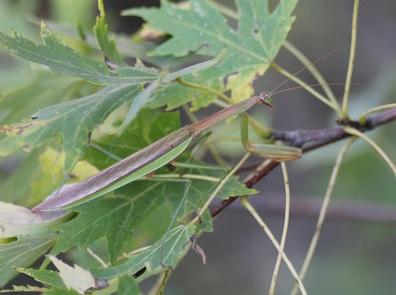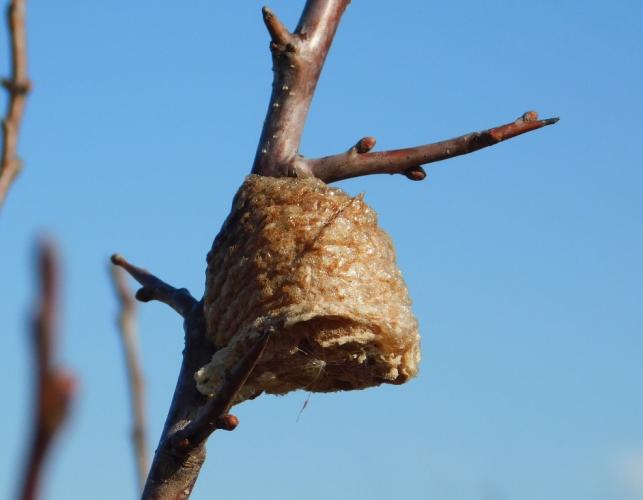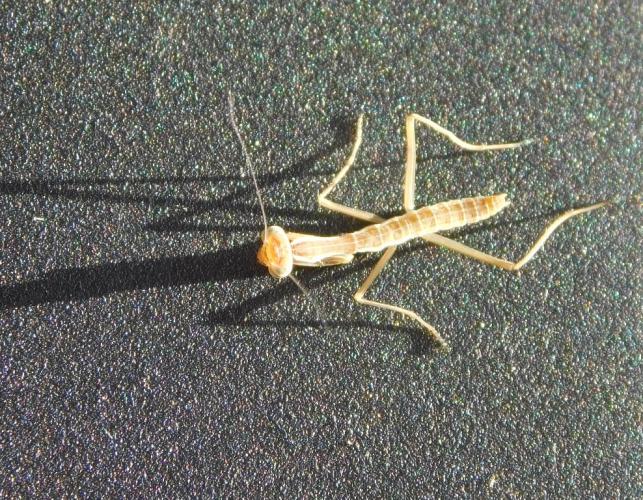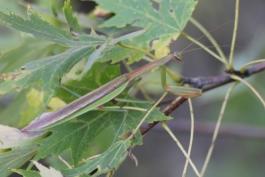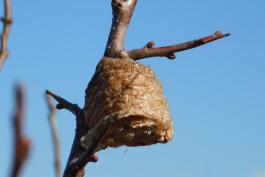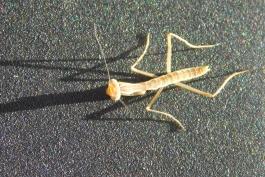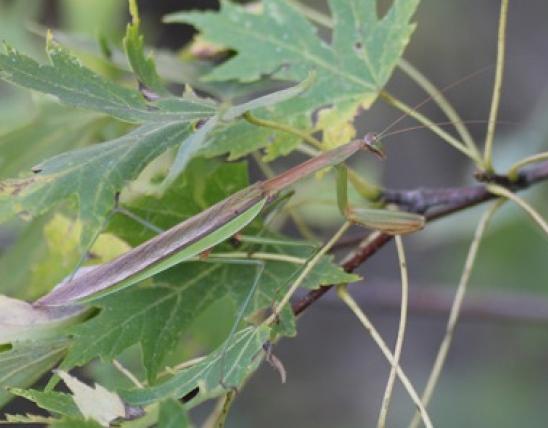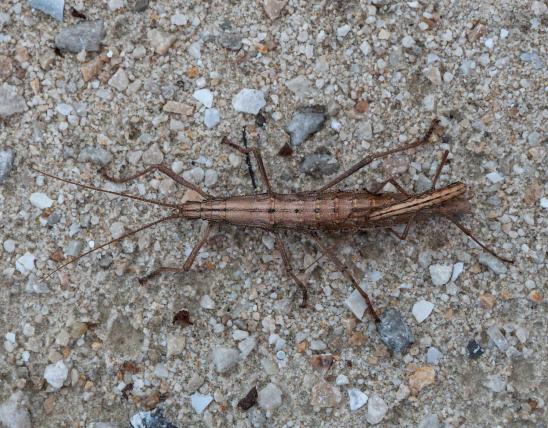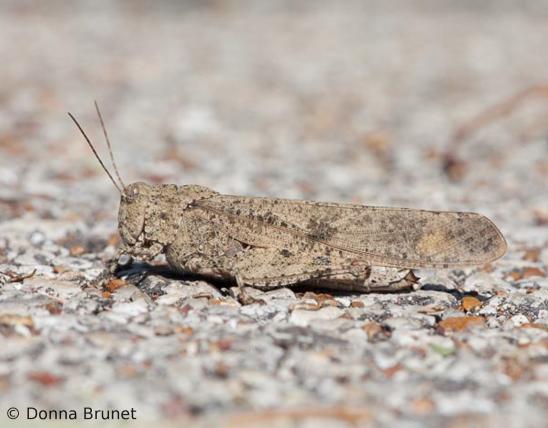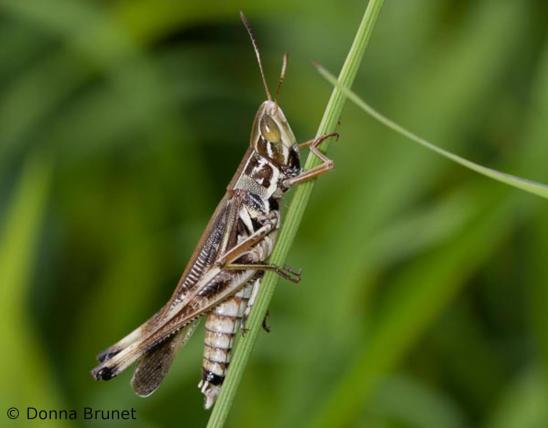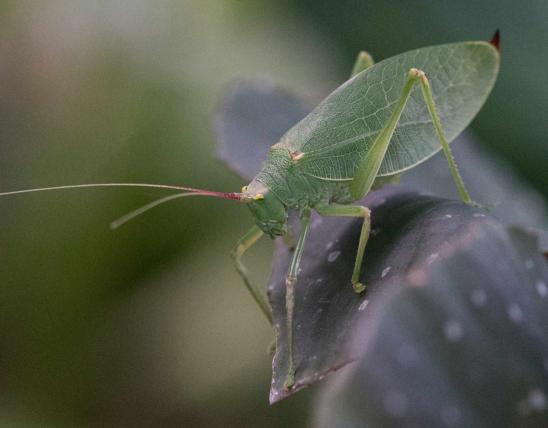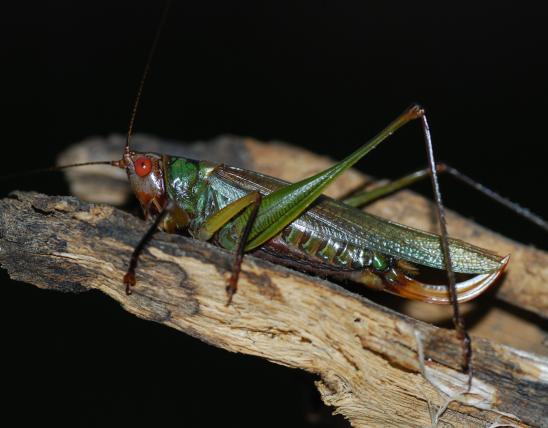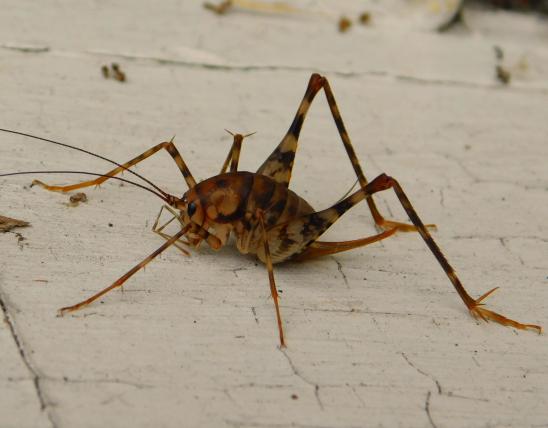
Most people recognize mantids, or mantises, when they see them. They’re large, elongated insects with triangular heads that can swivel around. The color is usually tan, grayish, or green. The top two corners of the triangular head are dominated by the bulging compound eyes. The first pair of legs are raptorial — they are perfect for grasping and holding prey, just like a raptor’s claws. To this end, the forelegs are large, powerful, and equipped with spines. When not in use, these forelegs are usually held up and folded together, making it look like the insect has its hands held together in prayer (hence the name praying mantis).
Immature mantids look a lot like the adults, but without fully developed wings. Very young mantids often have the abdomen tip curled upward.
It is possible to identify Missouri’s three main species of mantids by the shape of the egg cases (oothecae).
Although mantids are easy to identify as a group, it takes more practice to distinguish among Missouri’s different mantid species. Three species are most common in our state.
- Carolina mantis (Stagomantis carolina). Native.
- Pale green to tan or mottled gray
- Adult length 2–2¼ inches
- The combined length of the head and thorax is about as long as the abdomen.
- The middle pair of legs are about twice as long as the antennae.
- Females are essentially flightless, as their wings are relatively small — when folded, they do not extend as far as the abdomen tip; usually only about three-fourths of the way down the body.
- Males may have the wings extend beyond the abdomen tip and may fly to lights at night.
- There is a black patch on the outer pair of wings.
- Examine the facial shield (the part of the face in front of the antennae and between the eyes: in this and other Stagomantis species, it is long and narrow (in the Chinese mantis, it is fairly square and has vertical stripes).
- Egg cases are somewhat flattened, elongated, teardrop-shaped structures.
- Chinese mantis (Tenodera sinensis). Nonnative. Very commonly encountered.
- Tan to pale green; tan individuals often show a stripe of pale green on the side (it’s the borders of the green front wings)
- Adult length 2¼–4 inches or more
- Examine the facial shield (the part of the face in front of the antennae and between the eyes): in the Chinese mantis, it is fairly square and has vertical stripes (in our native Carolina mantis, it is long and narrow and lacks stripes).
- Flies well, often attracted to lights at night.
- Egg cases resemble tan toasted marshmallows. They are fairly round, about as long as wide, Ping-Pong-ball size; usually attached to twigs of bushes and small trees.
- Native to east Asia. Introduced to North America accidentally in 1896. Later, imported on purpose in hopes of combatting insect pests. Among the many insects it consumes are our smaller native mantids, and it may be playing a role, in some regions, in the declining populations of the Carolina mantis. Because the Chinese mantis has been widespread in our country for so long, it is difficult to determine what its ecological impact has been on native ecosystems. Because of the females’ large size, they have occasionally been recorded eating small vertebrates, including small reptiles and amphibians and even hummingbirds, but these seem to be relatively rare occurrences that do not have a significant impact on populations of those species.
- European mantis or praying mantis (Mantis religiosa). Nonnative; probably the least encountered of these three.
- Yellowish green, cream-colored, or tan.
- Adult length 2–3 inches
- Diagnostic feature is a round black dot on the underside of the basal joint (coxa) of the forelegs. Sometimes this black dot has a white center. This spot can be hard to see when their “arms” are held together.
- Egg cases are rather egg-shaped, distinctly layered structures.
- Native to Europe. Introduced to North America accidentally in 1899. Later, imported on purpose in hopes of combatting insect pests. People may still introduce them occasionally in our state.
Adult length: 2 to more than 4 inches (varies by species).
Statewide.
Habitat and Conservation
Mantids frequent open, highly vegetated areas such as gardens, old fields and pastures, thickets, woodland borders, and other places where an abundance of plant types attract a wide variety of insects. Mantids, like ambush and assassin bugs, crab and jumping spiders, and robber flies, wait motionless for prey insects to draw near, then grab them in a lightning-fast move.
Many people are concerned that nonnative mantids may be outcompeting our native North American mantids, contributing to their decline. These people selectively destroy individual Chinese and European mantids, and their egg cases, letting our native Carolina mantis species alone. Meanwhile, other people purchase nonnative Chinese mantid egg cases and release them in an attempt to battle garden pests.
Food
Mantids eat a wide variety of flying and walking insects and their caterpillars — pretty much anything they can grab, including other mantids. They are ambush predators. They rest quietly on vegetation in sunny open areas, often near flowers, waiting for another insect to walk or fly near. Mantids blend in with their surroundings, and they stalk their prey slowly, snatching their prey with a quick grab. The spines on the strong forelegs help the mantid grasp the prey, while the mantid nibbles away at its meal.
Life Cycle
Most mantids live for only about a year. They hatch in spring and spend the rest of the growing season eating, growing, and molting. They mate and lay eggs in late summer and die when it freezes. Eggs overwinter in egg cases (ootheca).
At the end of the growing season, females have large abdomens full of eggs. They deposit their eggs onto twigs, bark, or other structure in masses called ootheca. The eggs are extruded within a glob of frothy material called spumaline, which, when it hardens, feels something like crusty, dry Styrofoam. The tough ootheca egg case protects the eggs all winter. In spring, the young hatch out almost all at once. If they cannot disperse right away, they will eat each other.
The mating of mantids is famous, because the female sometimes eats the male during copulation, starting with his head. The male’s body is able to complete sperm transfer, even though his head is missing. The female usually ends up eating the rest of the male. This seems ghoulish, but remember that mantids would eat one another almost anytime, if confined in close quarters. Also, many of the times this cannibalism has been recorded, it occurred in captivity; it appears to be less frequent in nature.
In a very real way, the male’s sacrifice helps ensure that his offspring will survive. His body helps nourish his mate, contributing to her health and her production of high-quality eggs and egg cases. And the female’s hunting instinct and ravenous appetite serves her by helping to ensure she hunts steadily at a time when she needs plenty of food.
Human Connections
It is tempting to simply label all insect-eating insects as “beneficial,” but black-and-white judgments on the human value of mantids are problematic. Mantids eat many pest insects, but they also eat insects that humans tend to appreciate, such as other insect predators, pollinators, butterflies, and so on.
Egg cases of nonnative mantids, including the Chinese mantis, are bought and sold in many places in the hope of controlling agriculture and garden pests. Because of their indiscriminate diet (eating beneficial as well as pest insects) their usefulness is questionable. If you want to control pests biologically, by encouraging a variety of insect predators, avoid using broad-spectrum insecticides.
Because of the Chinese mantid’s possible role in the decline of some native North American mantids, the use of that species seems ill-advised. If you want to experiment with mantids as pest control agents, try using the egg cases of our native Carolina mantis.
Mantids are often described not just as “predators” but as “deadly predators.” A moment’s reflection reveals the emotional and redundant charge in the latter phrase. We humans feel satisfied when mantids consume invasive stinkbugs, annoying houseflies, or moths whose caterpillars chomp our tomato plants, but it disturbs us when they capture honeybees, pretty butterflies, or other seemingly innocent insects.
Ecosystem Connections
Usually when we consider insects that play a role in the food chain, we think of herbivorous insects, which eat plants and pass the nutrients along to insect-hunting birds, amphibians, reptiles, bats, and other vertebrates. But mantids and other insect-hunting insects are generally larger than the insects they hunt and provide a bigger meal for an insect-hunting vertebrate. Many birds, especially, hunt insects during breeding season because of their high protein content.
As with many other species, the young are particularly vulnerable to predation. Mortality is high among immature mantids, as their bodies become food for a wide variety of predators. Jumping spiders, for example, patrol the same plant stems that young mantids walk around on, and they won’t hesitate to pounce on young mantids small enough to subdue.
Mantids can hear the high-frequency sounds emitted by bats, and if a mantid is flying, it will alter its flight in response. This is a sign that bats may be a primary predator of night-flying mantids.
Mantids aren’t the only species where the male is sometimes eaten by the female. In many spiders, the female may eat her much smaller mate. And in a more general way, in many animals, males that share in the rearing of offspring — establishing and defending a territory that supplies sufficient food, constructing nests, protecting or incubating eggs, gathering food, feeding the young, caring for the mother — are spending a significant amount of their lives in order to ensure their reproductive success.
What’s up with their eyes? There’s usually a dark spot on the eyes of mantids (and several other insects with compound eyes), and that dark spot always seems to be facing you, no matter what angle you view them from. How does this work? It’s caused by the structure of their compound eyes — essentially, a result of tubes, shadows, and mirrors. To understand this, imagine a model: Think of their globe-shaped compound eyes as a cluster of narrow tubes, all pointing outward from a center point, and imagine these tubes are coated with silver on the inside surfaces. Closest to you, the tubes are pointed directly at you, and you can see into the whole long (dark) tunnel, while the tubes increasingly angled away from you appear light-colored, reflecting the light.
Taxonomically, mantids (order Mantodea) are most closely related to roaches and termites (order Blattodea); they are in the same superorder (Dictyoptera). In the past, mantids, roaches, termites, and stick insects (such as walkingsticks) were all grouped together with the grasshoppers, crickets, and katydids in the order Orthoptera.



